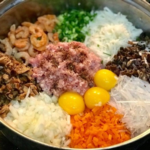Cha Ram and Cha Gio are two distinct dishes that share some similarities in their preparation methods, such as using rice paper to wrap the filling and then frying it. However, there are several key differences that set them apart. Let’s explore these differences to understand each dish better.
1 Rice Paper for Wrapping
Cha Ram uses a specific type of rice paper that is meant for wrapping.
On the other hand, Cha Gio can be wrapped in either bánh rế (a type of crispy, net-like rice paper) or bò bía rice paper.

2 Differences in Filling
The filling for Cha Ram usually consists of river shrimp and fatty pork, along with other ingredients of your choice.
Cha Gio, on the other hand, has a more complex filling that typically includes leaner pork, taro, shrimp, and a variety of other ingredients.
3 Size Variations
Cha Ram is typically smaller in size, about the width of a finger, resulting in a crispier texture.
Cha Gio, in contrast, is significantly larger, often two to three times the size of Cha Ram.

We hope this article has helped clarify the differences between Cha Gio and Cha Ram. Now you can confidently distinguish between these two delicious dishes!
You may also like:
High Demand for ‘Super Giant’ Chili Pepper Despite Expensive Cost
The talk of the town is a new breed of “giant super chili” pepper that has been making an appearance. It’s powerful heat and hefty price tag is creating an excitement as people line up in anticipation of tasting this fiery vegetable. Want to know more about this mysterious discovery? Read on to find out more!
Choosing the Right Size Kitchen Island
Are you looking to maximize your kitchen space? A kitchen island might be the perfect solution! But what exactly is a kitchen island and how can you choose the right size for your kitchen? In this article, we’ll delve into the basics of kitchen islands and explore the optimal size for maximum efficiency.






































